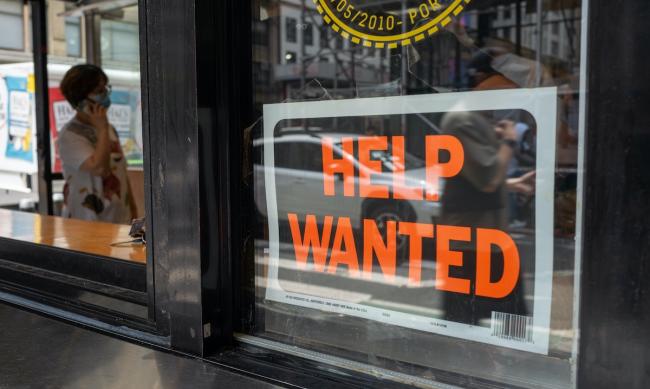Articles Menu

09.18.2022
usinesses can’t find workers. It’s not a unique complaint, but it is a growing one. It may have been an occasional employer gripe before COVID-19 arrived on the scene, but it grew as the pandemic did. And while the business world is eager to point its finger at government supports — and workers themselves — for the dearth of available labor, they have only themselves to blame for the challenges they face.
Searching to understand the labor challenge, we need to consider the handful of causes that can explain changes to the labor market. In Canada, the pandemic resulted in roughly forty thousand excess deaths from January 2020 to March 2022. According to Statistics Canada, that is “7.4 percent more deaths than would have been expected if there were no pandemic, after accounting for changes in population such as aging.” Those numbers include a jump in deaths of individuals under forty-five years old. Consistent with the Canada’s persistent failure to care for disabled people, the pandemic also led to a rise in disability. According to disability rights advocates, this is a development for which the country wasn’t prepared.
Throughout the last two years, many Canadians have retired too. This shouldn’t come as a surprise. As economist Armine Yalnizyan told the Canadian Broadcasting Corporation, the demographic shift toward an older population — and the consequent uptick in retirements — was “the slowest-moving train on the planet. It was predictable sixty to sixty-five years ago, and we have done nothing about it.” As Yalnizyan points out, “we knew this transition was going to happen.” The purported nimbleness of liberal democracies is meant to be custom-built to deal with such shifts, and yet no such thing has happened. The free market is meant to quickly adjust to demographic and other changes and the state is meant to enable, or at least preserve, its capacity to do just that. As usual, the promise of free-market efficiency turns out to be grievously overblown.
Employers in Canada couldn’t have predicted a pandemic, though, like the state itself, they could have better prepared for one. And they certainly could have prepared, along with the state, for the demographic shift caused by the retirement of the boomer generation that left so many job vacancies in its wake. Neither the state nor the market prepared for a rainy day — and certainly not for a long deluge. The retirement wave and pandemic, neither of which were adequately anticipated, helped to produce a significant labor challenge. Now defenders of the status quo are quick to blame labor for their own mistakes and lack of preparation.
There is much more to the labor shortage than a worker shortage, however. Indeed, as David Macdonald, an economist with the Canadian Centre for Policy Alternatives, argues, the worker shortage is actually a wage shortage. This is an essential point to consider. Sorting through the Statistics Canada data, Macdonald finds “jobs aren’t being filled ‘at the wages offered.’” Moreover, Macdonald finds “the dramatic decrease in the job seeker to job vacancy ratio in 2021 was caused almost entirely by employers posting substantially more jobs.”
Those who would explain the labor challenge as driven solely by the pandemic and retirements must contend with the fact that “the count of unemployed Canadians has remained stable, sitting at about 1.2 million pre-pandemic compared to 1 million today.” As Macdonald asks, with so many unemployed Canadians, why can’t businesses find employees? After all, there are still millions of unemployed folks. His answer: wages are too low.
Low pay affects at least in several key industries, including manufacturing, transportation and warehousing, public administration, agriculture, construction, education, retail trade, and more. On top of insufficient wage offerings, many workers are burned out and many jobs offer unacceptable terms and working conditions. Again, the fault lies with employers.
To say that employers are to blame for the worker — that is, wage — shortage is to say capitalism is to blame. The logic of profit maximization, inherent to the free-market system, is predicated on controlling (that is, suppressing) wages. It’s the same as it ever was. In the United States, real wages have been stagnant or low for decades. In Canada, the same was true in recent decades and is true today.
Except now labor is pushing back, demanding and expecting better wages and better treatment too. Where this cashes out is hard to say. Recent months have seen significant union victories in Canada and the United States. That’s encouraging. But union rates remain low after years of decline in recent decades, especially in the private sector. While the public sector boasted a 77.2 percent unionization rate in 2021 — up from 75.4 percent in 2017 — the private sector managed just 15 percent, down from 16.4 percent in 2017. That gives Canada an aggregate rate of 30.9 percent.
Workers ought to take advantage of this moment and use the leverage they have, securing their future by demanding higher wages and better working conditions. As the country faces an affordability crisis, rising interest rates, and an uncertain future — with the specter of even greater austerity under a Conservative government — the moment to strike is now.
When we talk about the labor shortage, we ought to talk about it as a wage shortage — a wage shortage made all the worse by poor working conditions and burnout. Our critique ought to be a critique of employers, not workers. Expecting workers to take whatever is on offer from “the market” is to expect them to be fodder for production and capital accumulation. Such expectations are fundamentally unjust. Instead, we should assess this moment as a potential turning point at which workers can demand justice — better wages and conditions — and can consolidate this temporary leverage by unionizing. The door is open. The time to go through it is now.
[Top photo: Canada's "labor crisis" is actually a wage crisis. (Spencer Platt / Getty Images)]